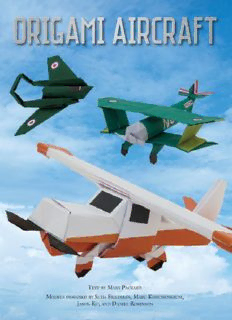
Origami Aircraft PDF
Preview Origami Aircraft
T M P EXT BY ARY ACKARD M S F , M K , J K , ODELS DESIGNED BY ETH RIEDMAN ARC IRSCHENBAUM ASON U D R AND ANIEL OBINSON D M N IAGRAMS BY ARCIO OGUCHI San Diego, California Thunder Bay Press An imprint of the Baker & Taylor Publishing Group 10350 Barnes Canyon Road, San Diego, CA 92121 www.thunderbaybooks.com Copyright © 2014 Thunder Bay Press Developed by The Book Shop, Ltd. Models designed and folded by Seth Friedman, Marc Kirschenbaum, Jason Ku, and Daniel Robinson Diagrams by Marcio Noguchi Box, book, and origami papers designed by Tim Palin Creative Edited by Masao Donahue Photography of origami models by Andrew Werner Photography Photo Credits: Thinkstock 4, 5, 8, 22, 28, 54, 76, 92, 100, and backgrounds throughout; Dreamstime 9, 40, 41, 67, 108; Bridgeman Archives 29, 66. Copyright under International, Pan American, and Universal Copyright Conventions. All rights reserved. No part of this book may be reproduced or transmitted in any form or by any means, electronic or mechanical, including photocopying, recording, or by any information storage-and-retrieval system, without written permission from the copyright holder. Brief passages (not to exceed 1,000 words) may be quoted for reviews. “Thunder Bay” is a registered trademark of Baker & Taylor. All rights reserved. All notations of errors, omissions, and permissions should be addressed to Thunder Bay Press, Editorial Department, at the above address. All other correspondence (including author inquiries) concerning the content of this book should be addressed to The Book Shop, LTD. New York, New York 10010. www.thebookshopltd.com ISBN-13: 978-1-62686-286-9 Note: The printed edition of this kit includes specially designed origami paper and stickers and is available through Amazon.com (ISBN-13: 978-1-62686-172-5). CONTENTS BEGINNING OF FLIGHT SYMBOLS, BASIC FOLDS AND BASES SOPWITH CAMEL SOPWITH CAMEL MODEL FOKKER DR.1 FOKKER DR.1 MODEL THE SPIRIT OF ST. LOUIS THE SPIRIT OF ST. LOUIS MODEL DOUGLAS DC-3 DOUGLAS DC-3 MODEL SUPERMARINE SPITFIRE SUPERMARINE SPITFIRE MODEL HUGHES H-4 HERCULES (SPRUCE GOOSE) HUGHES H-4 HERCULES (SPRUCE GOOSE) MODEL CESSNA 150 CESSNA 150 MODEL BOEING 707 BOEING 707 MODEL DE HAVILLAND SEA VIXEN DE HAVILLAND SEA VIXEN MODEL CONCORDE CONCORDE MODEL ABOUT THE ARTISTS Mechanical drawings done by Leonardo da Vinci reflect the first attempts to visualize viable flying machines. BEGINNING OF FLIGHT “O , NCE YOU HAVE TASTED FLIGHT YOU WILL FOREVER WALK THE EARTH WITH YOUR EYES , , TURNED SKYWARD FOR THERE YOU HAVE BEEN AND THERE YOU WILL ALWAYS LONG TO .” RETURN —Leonardo da Vinci (1452–1519) A Cambodian stamp depicting a da Vinci design. From mythological Icarus, whose man-made wings led him too close to the sun, to Leonardo da Vinci, whose designs for flying machines were way before their time, human beings have always dreamed of flying. Not until 1903 did this become a reality when the Wright Brothers—Orville and Wilbur—took to the skies in their homemade airplane. As momentous as that flight was, it lasted less than a minute. It took another five years for Wilbur Wright to demonstrate a plane capable of sustained flight. It is hardly surprising that a mere six years later, at the outset of World War I, aviation was still rudimentary at best. In 1914, there was considerable debate over whether aircraft could be an effective tool of war. In previous conflicts, cavalry had been the first choice for gathering reconnaissance. Since cavalry was proving too vulnerable against the enhanced weaponry of twentieth- century armies, it seemed planes fitted with cameras would be a far more viable alternative—and were they ever. Both sides found reconnaissance planes so effective at pinpointing enemy positions that neither side could gain an advantage. The result was an utter stalemate in the trenches. As the war progressed, innovations to aircraft resulted in an increasing number of battles in the air. In 1916, German planes were far superior to those flown by any of the allied countries, and this shifted the power to Germany. It became increasingly important to destroy those spies in the skies. A new plane was needed to bolster the Allies’ airpower. SYMBOLS Edge Existing crease Valley fold Mountain fold View from here Fold in front Fold behind Fold and unfold Hidden lines Crimp Equal parts reference Rotate Sink / Squash / Push Turn over Open Repeat steps on this side Magnify Close up detail next Pleat Reference point Reference for orientation Curl Cut down to size
